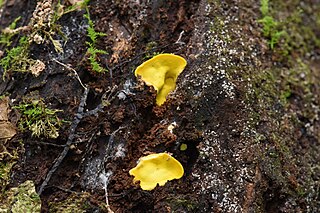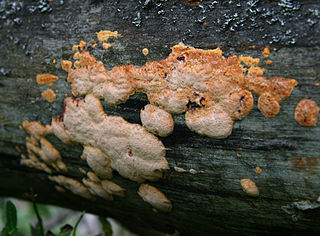
Polypores are a group of fungi that form large fruiting bodies with pores or tubes on the underside. They are a morphological group of basidiomycetes-like gilled mushrooms and hydnoid fungi, and not all polypores are closely related to each other. Polypores are also called bracket fungi or shelf fungi, and they characteristically produce woody, shelf- or bracket-shaped or occasionally circular fruiting bodies that are called conks.
Edred John Henry Corner FRS was an English mycologist and botanist who occupied the posts of assistant director at the Singapore Botanic Gardens (1929–1946) and Professor of Tropical Botany at the University of Cambridge (1965–1973). Corner was a Fellow of Sidney Sussex College from 1959.

The Polyporaceae are a family of poroid fungi belonging to the Basidiomycota. The flesh of their fruit bodies varies from soft to very tough. Most members of this family have their hymenium in vertical pores on the underside of the caps, but some of them have gills or gill-like structures. Many species are brackets, but others have a definite stipe – for example, Polyporus badius.

The Auriculariales are an order of fungi in the class Agaricomycetes. Species within the order were formerly referred to the "heterobasidiomycetes" or "jelly fungi", since many have gelatinous basidiocarps that produce spores on septate basidia. Around 200 species are known worldwide, placed in six or more families, though the status of these families is currently uncertain. All species in the Auriculariales are believed to be saprotrophic, most growing on dead wood. Fruit bodies of several Auricularia species are cultivated for food on a commercial scale, especially in China.

The Auriculariaceae are a family of fungi in the order Auriculariales. Species within the family were formerly referred to the "heterobasidiomycetes" or "jelly fungi", since many have gelatinous basidiocarps that produce spores on septate basidia. Around 100 species are known worldwide. All are believed to be saprotrophic, most growing on dead wood. Fruit bodies of several Auricularia species are cultivated for food on a commercial scale, especially in China.

Donkioporia is a genus of fungi in the family Fomitopsidaceae. The genus consists of two resupinate (crust-like) species: the type Donkioporia expansa, and D. albidofusca, which was transferred to the genus in 2010.
Gilbertsonia is a fungal genus in the family Fomitopsidaceae. This is a monotypic genus, containing the single brown rot species Gilbertsonia angulipora, found in the United States. Gilbertsonia is characterized by a dimitic hyphal system with clamped generative and well-developed binding hyphae. The generic name honors mycologist Robert Lee Gilbertson.

Flaviporus is a genus of poroid fungi in the family Steccherinaceae.

Aurantiporus is a genus of poroid fungi in the family Meruliaceae. Circumscribed by American mycologist William Alphonso Murrill in 1905, the genus contains five species found mostly in northern temperate regions. Molecular analysis of several Aurantiporus species suggests that the genus is not monophyletic, but some other related polypore species need to be sequenced and studied before appropriate taxonomic changes can be made. In 2018, Viktor Papp and Bálint Dima proposed a new genus Odoria to contain Aurantiporus alborubescens based on multigene phylogenetic analyses. The generic name is derived from the Latin aurantius ("orange") and the Ancient Greek πόρος (pore).

Datronia is a genus of poroid crust fungi in the family Polyporaceae. The genus was circumscribed by Marinus Anton Donk in 1966, with Datronia mollis as the type species. Datronia fungi cause a white rot in hardwoods. Datronia contains six species found in northern temperate areas. The most recent addition, Datronia ustulatiligna, was described in 2015 from Himachal Pradesh in India.

Dichomitus is a genus of poroid crust fungi in the family Polyporaceae. It was circumscribed by English mycologist Derek Reid in 1965.

Diplomitoporus is a genus of fungi in the family Polyporaceae. The Dictionary of the Fungi estimated the widespread genus to contain 11 species; since then, the genus has grown with the additional of several newly described species, and some transfers from other genera. Diplomitoporus has been described as a wastebasket taxon, containing "species that share common macroscopic and microscopic characteristics, but are not necessarily related."

Erastia is a fungal genus in the family Polyporaceae. It is a monotypic genus, containing the single European species Erastia salmonicolor. Erastia was circumscribed by Finnish mycologists Tuomo Niemelä and Juha Kinnunen in 2005. It is named in honour of the Estonian mycologist Erast Parmasto, "the eminent researcher of fungal taxonomy and cladistics".
Navisporus is a genus of seven species of tropical poroid fungi in the family Polyporaceae. It was circumscribed by Norwegian mycologist Leif Ryvarden in 1980 with Navisporus floccosus as the type species. This fungus, first described as Trametes floccosa by Giacomo Bresadola in 1896, is thought to have been originally collected in Tanzania.

Skeletocutis is a genus of about 40 species of poroid fungi in the family Polyporaceae. The genus has a cosmopolitan distribution, although most species are found in the Northern Hemisphere. It causes a white rot in a diverse array of woody substrates, and the fruit bodies grow as a crust on the surface of the decaying wood. Sometimes the edges of the crust are turned outward to form rudimentary bracket-like caps.

The hydnoid fungi are a group of fungi in the Basidiomycota with basidiocarps producing spores on pendant, tooth-like or spine-like projections. They are colloquially called tooth fungi. Originally such fungi were referred to the genus Hydnum, but it is now known that not all hydnoid species are closely related.
Eichleriella is a genus of fungi in the order Auriculariales. Species produce effused or cupulate, waxy to leathery basidiocarps on wood, with a smooth to spiny surface. The genus currently contains more than 15 species.
Protomerulius is a genus of fungi in the order Auriculariales. Basidiocarps are formed on dead wood and have an effused, smooth, spiny, or poroid hymenium. The genus is cosmopolitan.
Aporpium is a genus of fungi in the order Auriculariales. Basidiocarps are formed on dead wood and have a poroid hymenium. Species were often formerly referred to the genera Elmerina or Protomerulius, but molecular research, based on cladistic analysis of DNA sequences, has shown that Aporpium is a distinct, mainly north temperate genus.

Diplomitoporus flavescens is a species of poroid crust fungus in the family Polyporaceae.












